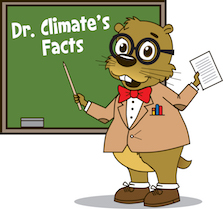Climate Change Lesson 3: The Greenhouse Effect
A term we hear often during any discussion about global warming is the greenhouse effect. If you've ever walked into a greenhouse on a sunny summer's day you instantly notice how much warmer the air is inside the greenhouse than outside. This is caused by sunlight entering through the glass of the greenhouse but not all of the energy is able to escape, heating the air inside the greenhouse. The Earth's atmosphere does the same thing as a greenhouse. Capturing the energy of the sun and holding that energy so the Earth stays warm and life can exist.
If the greenhouse effect is what keeps the Earth warm, then why do scientists say it's a problem? Along with energy, the atmosphere also works to hold in gases that exist in our atmosphere. One of these gases is carbon dioxide. Scientists are concerned that we produce more carbon dioxide than what the atmosphere can absorb. This leads to our temperatures rising and global warming.
In this lesson you will simulate the greenhouse effect with a classroom demonstration. If time allows and you have the resources, this can be modified into a small group activity.
Activity Level: Medium
Activity Time: 50 minutes, plus time needed for the demonstration.
Objectives:
Students will explore how the greenhouse effect happens by observing a classroom demonstration that simulates it.
Materials:
https://www.youtube.com/watch?v=ab6jV4VBWZE
Greenhouse effect pre-quiz.
Chart for recording temperature differences/changes during the demonstration.
Greenhouse Effect demonstration materials:
- Large glass jar with lid
- two thermometers
- wide strips of cardboard
- rubber bands
- bright light, such as a spotlight
Knowledge:
Give students the greenhouse effect pre quiz. Assure them this is just an exercise to find out how much they know about the Greenhouse Effect. When they are finished, if you like you can show them the NASA video, or use the pretest to start a discussion about the Greenhouse Effect, what it is and why scientists today are concerned about it.
Activity Intro:
Teacher: "What if we could recreate the Greenhouse Effect here in the classroom? We can do this here by creating a greenhouse with a glass jar and a thermometer inside to show the temperature when a light shines on it, like the sun shines on Earth."
Lesson Overview
Have students help with preparing the demonstration. If this is a small group activity assign roles to each student in the group.
Greenhouse Effect Demonstration Instructions
Using two strips of cardboard, bend the ends and use the rubber band to hold the bent ends together.
slip one of the thermometers between the pieces of cardboard and create a triangle shape to hold up the thermometer. Place the cardboard triangle with the thermometer into the jar. Put the lid on the jar.
Place the jar in a sunny window or shine a lamp directly on it. Leave the second thermometer outside the jar.
Every ten minutes, record the temperature inside the jar and outside the jar. Continue doing this until the teacher tells you to stop.
|
Time |
Temp. inside jar |
Outside Temp. |
|
|
|
|
|
|
|
|
|
|
|
|
|
|
|
|
Discussion Questions
What did the temperature inside the jar do? What happened to the thermometer outside of the jar?
If the demonstration continued for another hour, what would the temperature inside the jar most likely do?
What made the temperature inside the jar increase faster than the temperature outside the jar?
What is the jar supposed to represent?
Conclusion:
If there is time, have the students take the prequiz again as a postquiz to demonstrate their improvement in knowledge about the Greenhouse Effect and Global Warming.
Teacher Resource:
Greenhouse Effect demonstration materials:
- Large glass jar with lid
- two thermometers
- wide strips of cardboard
- rubber bands
- bright light, such as a spotlight
Student Resources:
Greenhouse Effect Demonstration Instructions
Using two strips of cardboard, bend the ends and use the rubber band to hold the bent ends together.
slip one of the thermometers between the pieces of cardboard and create a triangle shape to hold up the thermometer. Place the cardboard triangle with the thermometer into the jar. Put the lid on the jar.
Place the jar in a sunny window or shine a lamp directly on it. Leave the second thermometer outside the jar.
Every ten minutes, record the temperature inside the jar and outside the jar. Continue doing this until the teacher tells you to stop.
|
Time |
Temp. inside jar |
Outside Temp. |
|
|
|
|
|
|
|
|
|
|
|
|
|
|
|
|
Discussion Questions
What did the temperature inside the jar do? What happened to the thermometer outside of the jar?
If the demonstration continued for another hour, what would the temperature inside the jar most likely do?
What made the temperature inside the jar increase faster than the temperature outside the jar?
What is the jar supposed to represent?
Greenhouse Effect Pre-quiz
Name ___________________
True or False
- The Greenhouse Effect is something that is artificially created by humans. _____
- The Earth would not be able to keep warm without the greenhouse effect caused by the Earth's atmosphere. _____
- An overabundance of carbon dioxide has no impact on the Greenhouse Effect._____
- Deforestation contributes to the Greenhouse Effect _____
- When the Greenhouse Effect continues to make temperatures rise, this is called Global Warming. _____